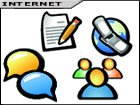
Well... The first week of school left very little time to get to doing any else but getting the school year rolling. For the most part, the opening of school was pretty uneventful, but there are always those one or two things that pop up that need to be attended to before you can really get the year moving. With a few exceptions, all of the new district teachers were able to access district technology resources on the first day of school. On a personal note, I am feeling invigorated as this year begins (my 19th in the SMUHSD), because I can see that there are enough resources that are free and accessible to teachers that can really make a big difference in teaching and learning.
At Capuchino, we started our new Global Communications course. This course embodies the skills of the read/write web and connects with the student's English and Health/Social Science course. All of the members of the Global Communications learning team met Thursday during the collaboration time to set up communication paths (wikis, online calendars, etc.) and to identify projects where the courses will have significant collaboration. I was really impressed with the energy and the flow of the meeting and felt we are really on the right track with what we are doing.
So, what are we doing? We are all about kids having skills, transferrable skills.
How are we going to achieve this in a way that kids will learn the skills and have fun at the same time? This is how I presented it to them. I want each one of them to become an expert in something. I really don't care what it is (as long as it is appropriate), but they have to have an interest in it and be passionate about it. The example I gave them was about a fictional punk band called the 'JellyRolls.' I want them to find everything they can read about the 'JellyRolls.' I want them to search the Internet, using search engines, like Google. I also want them to search blogs, using Technorati. I want them to subscribe RSS feeds about the 'JellyRolls' using a newsreader like 'Bloglines' or 'Rollyo.' I want them to use a news feeder to get the latest articles about the 'JellyRolls' latest concert and the reviews of the performance. I want them to bookmark pages on the Internet about the 'JellyRolls' using a tool like del.icio.us or Furl. And finally I want them to take the information they have collected and write about the 'JellyRolls' on a blog they have created. As they publish their blog using Blogger or some other blogging tool, they will undoubtedly come into to contact with other fans of the 'JellyRolls' and a dialogue will take place. This will increase their 'circle of influence' outside of their school or even their hometown, but will make them a 'player' in the global information society.
Do you think these skills will be transferrable into every class we teach?
As the District Technology Coordinator, I want to do what ever I can to encourage you to begin to tap into the enormous resources that are available to you and your students on the Internet and the site communication tools we have.(School Loop and Edline) The best part of all of this is that you don't have to write a grant to find funding for a project or get some special technology to make all of this work, its all available to you with any computer connected to the district network.
So, to encourage you to take part in the unfolding of the new resources available to you, I am going to make the following deal.
1) If you want to start a blog or Wiki with your class, I will come down and help you set it all up and even work with one of your classes to begin the process.
2) If you or your students start a blog or a wiki, I'll subscribe and read it religiously. I'll be the Edublog version of 'Tom' on 'myspace.'
3) I can come to your school site and work with a small group of teachers to help develop a wiki to create online resources for your classes. We can do this with several different wiki or blogging tools.
Is anyone going to take me up on my offer? Call or write me an e-mail if you are even the least bit interested....






